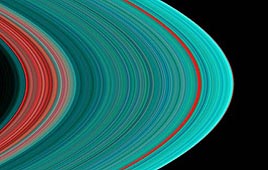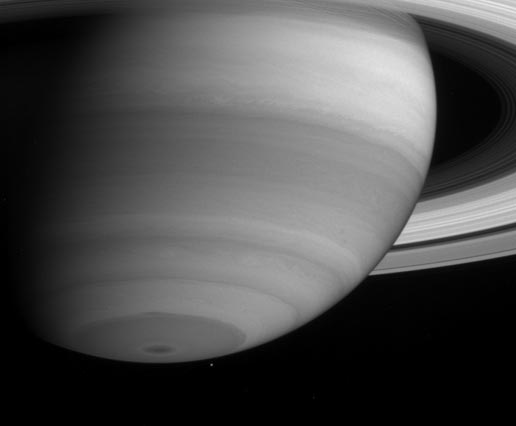More than $3 billion was invested in sending the Cassini spacecraft and the Higgins probe to the planet Saturn. The investment, it turns out, is justified mainly because of one of its moons - Titan * The Cassini spacecraft that began its mission last week, sent new photographs of the Saturn's famous rings. The images were developed by researchers

15.7.2004
By: Avi Blizovsky and a collection of sources
Direct link to this page: https://www.hayadan.org.il/saturn150704.html

Saturn's spectacular cloud bands reveal some interesting formations in this low-angle image taken by the Cassini spacecraft on May 20, 2004 and released for publication on July 14 on the NASA website. At a closer look, the sub-equatorial bands in the 20 degree south latitude area look like a braided rope. You can also clearly see eddies around the 60 degree south latitude. The 398 kilometer diameter moon Mims is visible just slightly to the right below Saturn's south pole.
The image was taken when Cassini was 22 million kilometers from Saturn's south pole with a filter focused at 727 nanometers. The resolution of the image is 131 kilometers per pixel. The contrast in the image has been increased to help understand the image.
Why are we interested in the planet Saturn?
July 11 2004
Titan in a NASA imaging photo. Similar conditions to Earth 4 billion years ago
The Cassini satellite has arrived at the planet Saturn. Between the rings there is "dirt"
Yuval Dror, Haaretz, writes (11/7/2005) that the planet Saturn has many oddities, but there is no doubt that the real wonder is the one that surrounds it - its hundreds of rings (of which seven rings are especially prominent). No one knows exactly how they were created and what they are made of. In fact, just hours after the Cassini spacecraft slipped through the rings last weekend and entered orbit around Saturn, it managed to shake scientists' confidence about what they thought they knew.
Until now, the scientists believed that the rings are made of ice particles and rocks and that there is an empty space between the rings. But now it turns out that between the rings there is a substance that the scientists named "dirt". The material is reminiscent of the material from which one of Saturn's moons, Phoebe, is made, which may have been involved in the formation of the rings after a powerful collision with the planet. But Faba is not the only one responsible for the rings. In recent days, Cassini has sent stunning images of the beauty of the rings, which confirm the theory that most of them were formed from the disintegration of icy celestial bodies captured by the gravity of Saturn and its moons. These celestial bodies exploded and dispersed into billions of particles that now surround the planet.
Titan, the time machine
Saturn is fascinating in itself, but not in its honor 3.3 billion dollars were invested in the construction and launch of the Cassini spacecraft. The real reason is its magnificent moon, "Titan" (giant), which is considered the largest of Saturn's 31 moons. What makes Titan so interesting is that its current state is similar to Earth 4 billion years ago, long before life developed on it. Because of this, it serves as a rare time machine, which stores chemical clues inside that may teach us how life began on Earth. Do you have to fly to Titan for that? It turns out that it is. Although over the years scientists have accumulated a vast amount of knowledge about the development of the Earth, no one still has a clear answer to the question: how life began on Earth.
This December, Cassini will send the Higgins probe, which will take measurements and send data when it lands on Titan. Cassini will photograph Titan from space. In the last few days, it transmitted the first pictures of the moon. The scientists expected to see oceans and rivers of water glistening for the cameras, but the images were vague and managed to confuse the researchers, whose response was: "It's unpleasant to say, but we don't understand what we're seeing here." Fortunately for them, Cassini will take about 300 more pictures in its journey around Saturn, some of which will also be dedicated to Titan.
The price of the secret of life
Cassini releases Higgins towards Titan. 260 scientists await each new chip of information
Cassini-Higgins is considered an extremely expensive project. Almost two decades of planning and construction ended on October 15, 1997, when the spacecraft was launched into space. It arrived at Saturn last Thursday, July 1, after traveling a distance of 3.5 billion kilometers. It now begins 76 revolutions around Saturn, which will last about four years. The Cassini-Higgins project is shared by the American space agency (which built Cassini), the European agency (which built Higgins) and the Italian agency (which built a special communications antenna).
The American taxpayer paid $2.6 billion for the project and the European taxpayer added $660 million. The various space agencies believe that if they decipher the secret of life on Earth, the taxpayers will see it as a justified expense.
The strangeness of Saturn
The first scientist to show interest in Saturn was Galileo Galilei. As early as 1610, he turned his telescope towards it and found strange bumps around the planet, which were later discovered to be rings.
Almost 400 years later, Cassini has been equipped with 12 types of scientific instruments capable of making 27 different measurements, and with a little luck all of these instruments will function in the harsh conditions of space. Thus, for example, Cassini's cameras know how to take normal images and infrared wavelength images. A radar, a spectrometer (a device that measures wavelengths of various materials and in this way deduces their nature), and more were integrated into the spacecraft. These instruments will allow scientists to measure the magnetic field of Saturn and its moons, analyze the chemical composition of the various particles and provide information that would have been collected by a human explorer. This information will be sent via a special antenna back to Earth, where it will be analyzed by a team of 260 scientists, who await with anticipation any new data.
Advertisement Saturn is one of the strangest planets in the solar system, and this is the secret of its charm. An astronaut who would land on it would discover a strange world: for example, it is impossible to set foot on solid ground, because Saturn has no soil - most of it is made of gas. In fact, it is the only planet in our solar system that is less dense than water. This means that if Saturn could be placed in a giant bath of water, it would float.
Later on, the astronaut would discover that he was suffering from rather wintry weather: using special equipment, scientists measured storms raging near Saturn's equator moving at a speed of 1,800 km/h. The astronaut also felt that the days were passing quickly and he was not enough to do anything. This is because Saturn rotates around its axis at a dizzying speed - every 10 hours and 14 minutes. If that's not enough, different parts of Saturn rotate at different speeds: the equatorial regions rotate fast while the regions near the poles rotate slower.
Cassini sent pictures of the rings
ynet adds that the Cassini spacecraft, which began its mission last week, has sent new ultra-violet images of Saturn's famous rings. The images were developed by researchers at the University of Colorado, and the rings were shown in shades of red and turquoise. The different colors are artificial and are meant to emphasize the different order of the rings.
Cassini researchers said that the spacecraft's four-year journey may reveal how the rings were formed, and if they are likely to disappear someday. The space scientists categorize the rings by letters: D, C, BA, F, G, E, when Huygens, the research probe, actually passed between F and G, where it became clear that two main cameras cannot receive data from the visible side of the spectrum. However, it can be learned that the rings being tested are made of a "dirtier" material, and are apparently smaller than the more glacial rings painted in turquoise. It seems that certain materials link the F ring to Prometheus, the white bubble at the bottom.
The "dirty" rings apparently contain organic substances, for example, ice mixed with water and ammonia. Some of the dirty rings are apparently made of the dominant material on the surface of the moon Pauva, a discovery that strengthens the claim that the rings were formed by the explosion of a more ancient moon.

One response
Why don't you write down the number of rings around the planet Saturn?